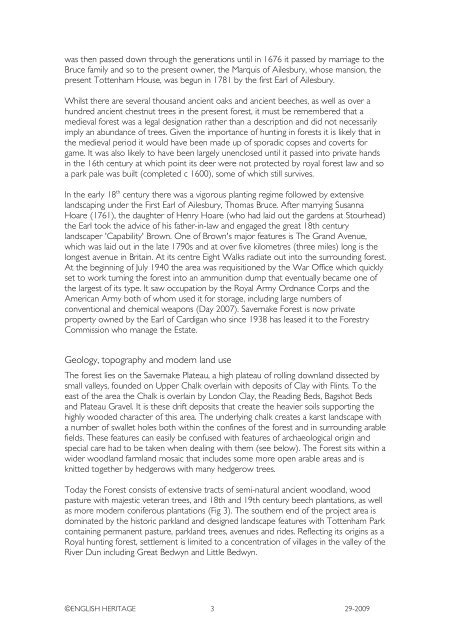savernake forest a report for the national mapping ... - English Heritage
savernake forest a report for the national mapping ... - English Heritage
savernake forest a report for the national mapping ... - English Heritage
You also want an ePaper? Increase the reach of your titles
YUMPU automatically turns print PDFs into web optimized ePapers that Google loves.
was <strong>the</strong>n passed down through <strong>the</strong> generations until in 1676 it passed by marriage to <strong>the</strong><br />
Bruce family and so to <strong>the</strong> present owner, <strong>the</strong> Marquis of Ailesbury, whose mansion, <strong>the</strong><br />
present Tottenham House, was begun in 1781 by <strong>the</strong> first Earl of Ailesbury.<br />
Whilst <strong>the</strong>re are several thousand ancient oaks and ancient beeches, as well as over a<br />
hundred ancient chestnut trees in <strong>the</strong> present <strong><strong>for</strong>est</strong>, it must be remembered that a<br />
medieval <strong><strong>for</strong>est</strong> was a legal designation ra<strong>the</strong>r than a description and did not necessarily<br />
imply an abundance of trees. Given <strong>the</strong> importance of hunting in <strong><strong>for</strong>est</strong>s it is likely that in<br />
<strong>the</strong> medieval period it would have been made up of sporadic copses and coverts <strong>for</strong><br />
game. It was also likely to have been largely unenclosed until it passed into private hands<br />
in <strong>the</strong> 16th century at which point its deer were not protected by royal <strong><strong>for</strong>est</strong> law and so<br />
a park pale was built (completed c 1600), some of which still survives.<br />
In <strong>the</strong> early 18 th century <strong>the</strong>re was a vigorous planting regime followed by extensive<br />
landscaping under <strong>the</strong> First Earl of Ailesbury, Thomas Bruce. After marrying Susanna<br />
Hoare (1761), <strong>the</strong> daughter of Henry Hoare (who had laid out <strong>the</strong> gardens at Stourhead)<br />
<strong>the</strong> Earl took <strong>the</strong> advice of his fa<strong>the</strong>r-in-law and engaged <strong>the</strong> great 18th century<br />
landscaper 'Capability' Brown. One of Brown's major features is The Grand Avenue,<br />
which was laid out in <strong>the</strong> late 1790s and at over five kilometres (three miles) long is <strong>the</strong><br />
longest avenue in Britain. At its centre Eight Walks radiate out into <strong>the</strong> surrounding <strong><strong>for</strong>est</strong>.<br />
At <strong>the</strong> beginning of July 1940 <strong>the</strong> area was requisitioned by <strong>the</strong> War Office which quickly<br />
set to work turning <strong>the</strong> <strong><strong>for</strong>est</strong> into an ammunition dump that eventually became one of<br />
<strong>the</strong> largest of its type. It saw occupation by <strong>the</strong> Royal Army Ordnance Corps and <strong>the</strong><br />
American Army both of whom used it <strong>for</strong> storage, including large numbers of<br />
conventional and chemical weapons (Day 2007). Savernake Forest is now private<br />
property owned by <strong>the</strong> Earl of Cardigan who since 1938 has leased it to <strong>the</strong> Forestry<br />
Commission who manage <strong>the</strong> Estate.<br />
Geology, topography and modern land use<br />
The <strong><strong>for</strong>est</strong> lies on <strong>the</strong> Savernake Plateau, a high plateau of rolling downland dissected by<br />
small valleys, founded on Upper Chalk overlain with deposits of Clay with Flints. To <strong>the</strong><br />
east of <strong>the</strong> area <strong>the</strong> Chalk is overlain by London Clay, <strong>the</strong> Reading Beds, Bagshot Beds<br />
and Plateau Gravel. It is <strong>the</strong>se drift deposits that create <strong>the</strong> heavier soils supporting <strong>the</strong><br />
highly wooded character of this area. The underlying chalk creates a karst landscape with<br />
a number of swallet holes both within <strong>the</strong> confines of <strong>the</strong> <strong><strong>for</strong>est</strong> and in surrounding arable<br />
fields. These features can easily be confused with features of archaeological origin and<br />
special care had to be taken when dealing with <strong>the</strong>m (see below). The Forest sits within a<br />
wider woodland farmland mosaic that includes some more open arable areas and is<br />
knitted toge<strong>the</strong>r by hedgerows with many hedgerow trees.<br />
Today <strong>the</strong> Forest consists of extensive tracts of semi-natural ancient woodland, wood<br />
pasture with majestic veteran trees, and 18th and 19th century beech plantations, as well<br />
as more modern coniferous plantations (Fig 3). The sou<strong>the</strong>rn end of <strong>the</strong> project area is<br />
dominated by <strong>the</strong> historic parkland and designed landscape features with Tottenham Park<br />
containing permanent pasture, parkland trees, avenues and rides. Reflecting its origins as a<br />
Royal hunting <strong><strong>for</strong>est</strong>, settlement is limited to a concentration of villages in <strong>the</strong> valley of <strong>the</strong><br />
River Dun including Great Bedwyn and Little Bedwyn.<br />
©ENGLISH HERITAGE 3 29-2009

















